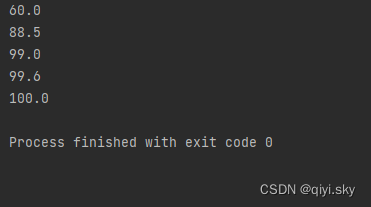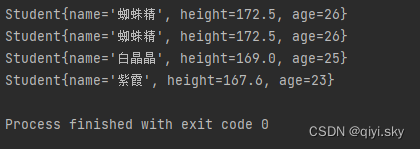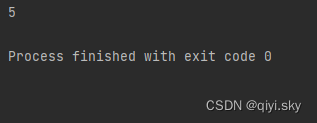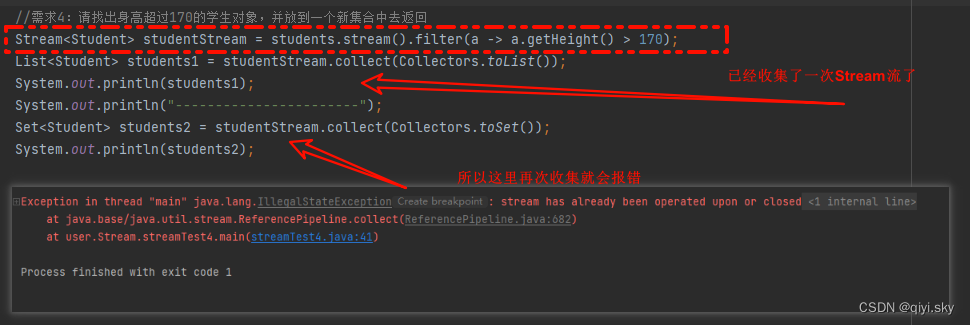目录
Stream流的中间方法
方法
案例演示
Stream流的终结方法
方法
案例演示1
收集
案例演示2
Stream流的中间方法
方法
- 中间方法指的是调用完成后会返回新的Stream流,可以继续使用(支持链式编程)。
| Stream提供的常用中间方法 | 说明 |
|---|---|
| Stream<T> filter(Predicate<? super T> predicate) | 用于对流中的数据进行过滤。 |
| Stream<T> sorted() | 对元素进行升序排序 |
| Stream<T> sorted(Comparator<?super T> comparator) | 按照指定规则排序 |
| Stream<T> limit(long maxSize) | 获取前几个元素 |
| Stream<T> skip(long n) | 跳过前几个元素 |
| Stream<T> distinct() | 去除流中重复的元素。 |
| <R> Stream<R> map(Function<? super T,? extends R> mapper) | 对元素进行加工,并返回对应的新流 |
| static <T> Stream<T> concat(Stream a,Stream b) | 合并a和b两个流为一个流 |
案例演示
需求1:找出成绩大于等于60分的数据,并升序后,再输出。
public class streamTest3 {public static void main(String[] args) {List<Double> scores = new ArrayList<>();Collections.addAll(scores,88.5,100.0,60.0,99.0,9.5,99.6,25.0);//需求1:找出成绩大于等于60分的数据,并升序后,再输出。scores.stream().filter(s -> s >= 60).sorted().forEach(s -> System.out.println(s));}
}
运行结果:

需求2:找出年龄大于等于23,且年龄小于等于30岁的学生,并按照年龄降序输出。
public class streamTest3 {public static void main(String[] args) {List<Student> students = new ArrayList<>();Student s1 = new Student("蜘蛛精", 172.5,26 );Student s2 = new Student("蜘蛛精",172.5,26);Student s3 = new Student("紫霞",167.6,23);Student s4 = new Student("白晶晶",169.0,25);Student s5 = new Student("牛魔王",183.3,35);Student s6 = new Student("牛夫人",168.5,34);Collections.addAll(students,s1,s2,s3,s4,s5,s6);//需求2:找出年龄大于等于23,且年龄小于等于30岁的学生,并按照年龄降序输出。students.stream().filter(s -> s.getAge() >= 23 && s.getAge() <= 30).sorted((o1,o2) -> o2.getAge() - o1.getAge()) //重载的sort方法.forEach(s -> System.out.println(s));}
}
运行结果:

需求3:取出身高最高的前3名学生,并输出。
//需求3:取出身高最高的前3名学生,并输出。students.stream().sorted((o1,o2) -> Double.compare(o2.getHeight(),o1.getHeight())).limit(3).forEach(s -> System.out.println(s));运行结果:

再简化输出语句:

需求4:取出身高倒数的2名学生
//需求4:取出身高倒数的2名学生
students.stream().sorted((o1,o2) -> Double.compare(o2.getHeight(),o1.getHeight())).skip(students.size() - 2).forEach(System.out::println);运行结果:

需求5:找出身高超过168的学生叫什么名字,要求去除重复的名字,再输出。
//需求5:找出身高超过168的学生叫什么名字,要求去除重复的名字,再输出。
students.stream().filter(s -> s.getHeight() > 168).map(Student::getName /* s->s.getName()*/ ).distinct().forEach(System.out::println);运行结果:

concat的使用
Stream<String> st1 = Stream.of("张三","李四");
Stream<String> st2 = Stream.of("张三2","李四2","王五");
Stream<String> allSt = Stream.concat(st1,st2);
allSt.forEach(System.out::println);运行结果:

Stream流的终结方法
方法
- 终结方法指的是调用完成后,不会返回新Stream了,没法继续使用流了。
| Stream提供的常用终结方法 | 说明 |
|---|---|
| void forEach(Consumer action) | 对此流运算后的元素执行遍历 |
| long count() | 统计此流运算后的元素个数 |
| Optional<T> max(Comparator<? super T > comparator) | 获取此流运算后的最大值元素 |
| Optional<T> min(Comparator<? super T> comparator) | 获取此流运算后的最小值元素 |
案例演示1
需求1:计算出身高超过168的学生有几人
public class streamTest4 {public static void main(String[] args) {List<Student> students = new ArrayList<>();Student s1 = new Student("蜘蛛精", 172.5,26 );Student s2 = new Student("蜘蛛精",172.5,26);Student s3 = new Student("紫霞",167.6,23);Student s4 = new Student("白晶晶",169.0,25);Student s5 = new Student("牛魔王",183.3,35);Student s6 = new Student("牛夫人",168.5,34);Collections.addAll(students,s1,s2,s3,s4,s5,s6);//需求1:计算出身高超过168的学生有几人long size = students.stream().filter(s -> s.getHeight() > 168).count();System.out.println(size);}
}
运行结果:

需求2:请找出身高最高的学生对象,并输出
//需求2:请找出身高最高的学生对象,并输出
Student s = students.stream().max((o1,o2) -> Double.compare(o1.getHeight(),o2.getHeight())).get();
System.out.println(s);运行结果:

需求3:请找出身高最矮的学生对象,并输出
//需求3:请找出身高最矮的学生对象,并输出
Student ss = students.stream().min((o1,o2) -> Double.compare(o1.getHeight(),o2.getHeight())).get();
System.out.println(ss);运行结果:

收集
- 收集Stream流:就是把Stream流操作后的结果转回到集合或者数组中去返回。
Stream流:方便操作集合/数组的手段;集合/数组:才是开发中的目的。
| Stream提供的常用终结方法 | 说明 |
|---|---|
| R collect(Collector collector) | 把流处理后的结果收集到一个指定的集合中去 |
| Object[] toArray() | 把流处理后的结果收集到一个数组中去 |
| Collectors工具类提供了具体的收集方式 | 说明 |
|---|---|
| public static<T> Collector toList() | 把元素收集到List集合中 |
| public static<T> Collector toSet() | 把元素收集到Set集合中 |
| public static Collector toMap(Function keyMapper,Function valueMapper) | 把元素收集到Map集合中 |
案例演示2
需求4:请找出身高超过170的学生对象,并放到一个新集合中去返回
//需求4:请找出身高超过170的学生对象,并放到一个新集合中去返回
List<Student> students1 = students.stream().filter(a -> a.getHeight() > 170).collect(Collectors.toList());
System.out.println(students1);
System.out.println("-----------------------");
Set<Student> students2 = students.stream().filter(a -> a.getHeight() > 170).collect(Collectors.toSet());
System.out.println(students2);运行结果:

注意:流只能收集一次 (就像是水喝光了,或者是迭代器的指针指到了最后的位置)
例如:

需求5:请找出身高超过170的学生对象,并把学生对象的名字和身高,存入到一个Map集合返回。
(需要手动去重)
//需求5:请找出身高超过170的学生对象,并把学生对象的名字和身高,存入到一个Map集合返回。
Map<String,Double> map =students.stream().filter(a -> a.getHeight() > 170).distinct().collect(Collectors.toMap(a -> a.getName(),a -> a.getHeight()));
System.out.println(map);运行结果:

Stream流收集为数组
Object[] arr1 = students.stream().filter(a -> a.getHeight() > 170).toArray();//如果不想要Object类型,则
Student[] arr2 = students.stream().filter(a -> a.getHeight() > 170).toArray(len -> new Student[len]);
System.out.println(Arrays.toString(arr2));运行结果:

END
学习自:黑马程序员——Java课程









)






)


